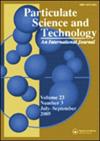基于PFC-FLAC耦合的大豆颗粒材料三轴试验数值模拟
IF 1.5
4区 工程技术
Q3 ENGINEERING, CHEMICAL
引用次数: 0
摘要
摘要采用离散-连续(PFC-FLAC)耦合方法模拟大豆颗粒材料的室内三轴试验。通过与实验室实际试验结果的对比,标定了大豆颗粒材料的细观力学参数,验证了建模方法的有效性。随后,基于颗粒位移场、速度场和力链网络,分析了大豆颗粒物料的颗粒运动规律和力学机理。结果表明,PFC-FLAC耦合方法能较好地描述大豆颗粒材料的宏观应力-应变关系、变形损伤特征和抗剪强度力学指标。随着围压(50 ~ 200 kPa)的增大,试件的胀形变形由均匀向集中不均匀转变。颗粒接触数和最大颗粒接触应力分别增加19.3%和48%。此外,还揭示了试件宏观性能随微观参数的变化规律。在相同条件下,试样的峰值应力变化与颗粒间摩擦系数成正比。随着有效模量的增加,应力-应变曲线的斜率逐渐增大。关键词:离散元法pfc - flac耦合大豆颗粒材料三轴压缩数值模拟披露声明作者未报告潜在利益冲突。本研究由[河南省高等学校青年骨干教师培训计划]资助,项目[no . 2020GGJS086];和[河南省高等教育重点科研项目计划](项目号23A560001)。本文章由计算机程序翻译,如有差异,请以英文原文为准。
PFC–FLAC coupling-based numerical simulation of triaxial test on soybean granular material
AbstractA discrete-continuous (PFC–FLAC) coupling method was used in this study to simulate laboratory triaxial tests with soybean granular material. The mesoscopic mechanical parameters of the soybean granular material were calibrated by comparing them with actual laboratory test results, and the validity of the modeling method was verified. Subsequently, the particle motion law and mechanical mechanism of the soybean granular materials were analyzed based on the particle displacement field, velocity field, and force chain network. The results showed that the coupled PFC–FLAC method could better describe the macroscopic stress–strain relationship, deformation damage characteristics, and shear strength mechanical indexes of soybean granular materials. With increasing confining pressure (50–200 kPa), the bulging deformation of the specimens changed from uniform to concentrated but uneven. The particle contact number and maximum particle contact stress increased by 19.3 and 48%, respectively. Additionally, variations of the macroscopic properties of the specimens with microscopic parameters were revealed. Under the same conditions, the change in the peak stress of the specimen was proportional to the interparticle friction coefficient. Moreover, the slope of the stress–strain curve increased gradually with an increase in the effective modulus.Keywords: Discrete element methodPFC–FLAC couplingsoybean granular materialtriaxial compressionnumerical simulation Disclosure statementNo potential conflict of interest was reported by the author(s).Additional informationFundingThis work was supported by the [Training Program for Young Backbone Teachers in Higher Education Institutions in Henan Province] under Grant [Number 2020GGJS086]; and [Henan Province Higher Education Key Research Project Plan] under Grant [Number 23A560001].
求助全文
通过发布文献求助,成功后即可免费获取论文全文。
去求助
来源期刊

Particulate Science and Technology
工程技术-工程:化工
CiteScore
4.40
自引率
4.00%
发文量
86
审稿时长
12 months
期刊介绍:
Particulate Science and Technology, an interdisciplinary journal, publishes papers on both fundamental and applied science and technology related to particles and particle systems in size scales from nanometers to millimeters. The journal''s primary focus is to report emerging technologies and advances in different fields of engineering, energy, biomaterials, and pharmaceutical science involving particles, and to bring institutional researchers closer to professionals in industries.
Particulate Science and Technology invites articles reporting original contributions and review papers, in particular critical reviews, that are relevant and timely to the emerging and growing fields of particle and powder technology.
 求助内容:
求助内容: 应助结果提醒方式:
应助结果提醒方式:


